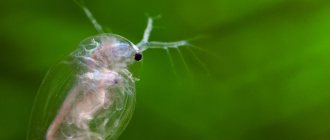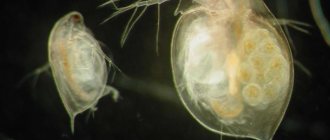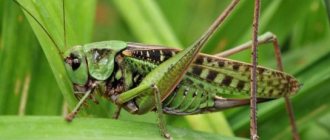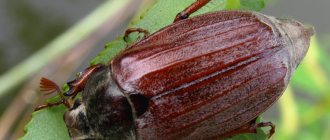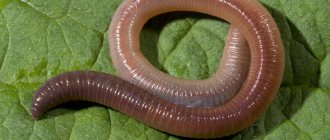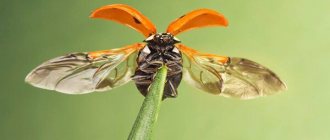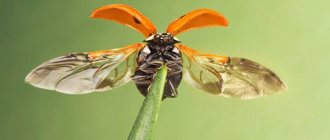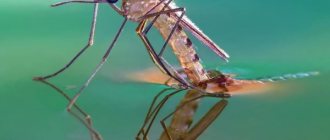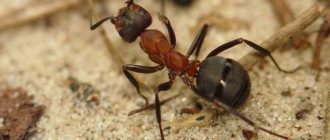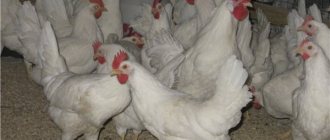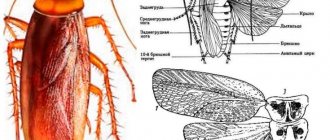- Wild animals
- >>
- Crustaceans
Daphnia is a small crayfish that lives mostly in fresh water bodies of the planet. Given their miniature size, they have a rather complex structure and serve as an important element of the ecosystem - by multiplying quickly, they allow fish and amphibians to feed, so that without them, reservoirs would be much emptier. They also feed the fish in the aquarium.
What is Daphnia
Common daphnia is a small crustacean. Thanks to its movement in sharp jerks, it received a second name - water flea.
Depending on the type, sizes can range from 0.2 mm to 6 mm. Large species reach the size of a small pea and can be seen without a microscope.
When magnified, the structure of the crustacean is clearly visible. The body of daphnia is slightly flattened on the sides and has an oval shape. On top it is dressed in a bicuspid leathery shell - the carapace, which ends in a tail needle and protects the internal organs.
Head
The head is covered with a hard chitinous covering. On it there is a beak-like outgrowth - the rostrum, under which there are short anterior antennae - antennules, which perform an olfactory function thanks to the short outgrowths with olfactory setae located on them. The posterior antennae are longer and covered with projections. They help daphnia move through the water column by making leaps.
Crustaceans have five pairs of legs of a complex structure. The thoracic legs of daphnia perform the main functions of respiration and nutrition. They are located on the head. Within one minute, the crustacean makes up to 500 strokes, passing through itself unicellular algae and bacteria suspended in the water. On the limbs there are gill sacs, which are filled with oxygen when they move.
Organ of vision
Daphnia have a paired organ of vision, which is double in mature individuals. Large compound eye, consists of 22 facets. In some species the number of facets can reach three hundred. Below the compound eye is the nauplial ocellus.
When magnifying the daphnia, the internal organs are clearly visible in the photo. The intestinal canal extends from the mouth opening. On the back side there is a pulsating heart. In females, between the body and the dorsal shell there is a brood chamber in which the eggs are located.
Description and features
Daphnia grow 2-5 mm in height and have fairly rounded bodies. Daphnia under a microscope: at the top is the head, clearly visible in most species under a magnifying glass, with a large, dark-colored compound eye and a much smaller eye. Water fleas are colored from reddish to light brown transparent.
Daphnia photo: to the right and left of the head, the legs stick out like oars, with the help of which it moves. At the end of the body there is a process. Females are light in color (summer eggs) or dark in color (winter eggs).
The water flea moves through the water in jerks, “jumping.” They usually swim in water; you will almost never see them sitting on substrate.
Where does Daphnia live?
A genus of Daphnia that lives in stagnant or slowly flowing fresh waters, and quite rarely they can even live in the sea. Water fleas in an aquarium for invertebrates (shrimp) are absolutely problem-free. In man-made pools they can be used to purify the water; in filtered pools they starve because it costs them too much energy to fight the current with their rowing legs. Shrimp love to eat dead water fleas and will sometimes even grab a living animal.
Life cycle
During the life of daphnia, there are a number of stages accompanied by molting: the first three are juvenile after 2, 24, 36 hours; fourth – egg maturation; fifth – laying eggs at intervals of 2-3 days; sixth - eggs are not laid. Daphnia lives from 26 to 47 days.
Natural enemies
Daphnia crustaceans use chemicals to detect whether their predators, the tufted mosquito larvae, are hunting nearby. In the presence of plastic, small aquatic life may be poorly equipped against predators. While eating, the predator releases substances into the water, which then signal to the prey that it is there. And then the victim will be able to protect itself from the predator. But water fleas are less able to protect themselves from predators if there is plastic in the water.
Places and living conditions
These cladocerans can be found in all ponds and lakes in different parts of the world.
Character and lifestyle
Large accumulations of crustaceans are observed in temporary reservoirs - ditches, puddles, small lakes with stagnant water. Getting into water even with a weak current, daphnia filter suspended particles of soil and clog the intestines. This makes it difficult for them to move and causes their death.
Crayfish spend most of their lives in the water column. Some species, filtering water, feed on microscopic algae, while others live near the bottom and eat dead particles of plants and invertebrates. Some varieties, halophiles, easily tolerate drought by hibernating.
These creatures are very voracious. The daily volume of food consumed can reach 600% of their own weight. Daphnia's main diet consists of bacteria, yeast and blue-green algae. The largest concentrations of crustaceans are observed in reservoirs with “blooming” water, where they reproduce especially intensively.
Daphnia reacts sharply to lighting. In bright light, it tries to stay closer to the bottom of the reservoir.
How to eat
They feed on blue-green bacteria and yeast. The largest number of individuals can be found in a reservoir where the water is blooming and where there are few fish.
Single-celled organisms filter water. The food that has been filtered enters the digestive organ and then moves along the esophagus. With its lips, with the help of salivary glands, the crustacean glues food into a ball. It is filtered from 2 to 10 ml per day. In case of cold weather, daphnia may hibernate. She can survive without food for a day, since there is always plant food in her stomach. In times of hunger, it feeds on the remains of dead plant food and the remains of invertebrate animals.
Appearance
Sex differences
Under favorable conditions, daphnia do not have males. Females give birth to their own kind. When conditions change, some females give birth to males.
Female and male individuals have some differences in external and internal structure:
- females are larger in size;
- on the head shield and outer cover of females there is a pattern of rhombuses and polygons, which is clearly visible when magnified;
- The first and second pairs of legs in males have hook-shaped projections that allow them to cling to females during mating.
Subspecies
About 150 species of these crustaceans live in natural conditions . Very often, several dozen species of crustaceans live in one body of water.
Daphnia magna
This variety is used as live food for aquarium fish due to its high nutritional value. The body length of the female is 3-5 mm, the male – no more than 2 mm. Newborns are microscopic in size. The main color of the outer cover is yellow or pinkish-orange. This species easily tolerates low temperatures. It is quite rare in nature, but in permanent habitats it is found in abundance. The lifespan of adult specimens is 3 months.
Daphnia pulex
The length of an adult female does not exceed 4 mm, a male – 1.5 mm. The color of the outer covers varies from light yellow to red. Externally, the crustaceans resemble Daphnia magna. The difference lies in their smaller size and life expectancy, which does not exceed one and a half months. The variety is characterized by incredible fertility. Females lay eggs every five days. Each clutch consists of 15 eggs.
A variety of water fleas
Small aquatic water fleas are crustaceans (Crustacea Cladocera). Only the smallest number of species live in the sea, the majority are found in inland waters. The Daphnia genus is often equated with water fleas, so they also often talk about “Daphnia” here, but this is not entirely correct. Aquatic fleas include many other genera, such as Moina, or so-called Scapholeberis because of their surface swimming, as well as the genus Bosmina - “proboscis crayfish”.
Daphnia pulex
Daphnia pulex is the most common type of water flea, usually 0.2–3.0 mm long, with eyes. Their bodies have a transparent shell, a folded shell-like structure covering the animal. On the head there is a dark-colored eye and numerous antennae used for touching and swimming.
Many daphnia, including D. pulex, have a specialized light-sensitive organ that looks like a tiny eye. Small mouthparts are located at the back. They mainly consist of mandibles for grinding food. The back of the body ends in two hook-shaped cuticular claws, used by the body to remove debris from the shell. Females have a brood chamber located between the body wall and the dorsal surface of the shell, used for transporting eggs.
Daphnia magna
Daphnia magna is a crustacean organism, 2-5 mm in length, oval in shape. Because of its transparent chitin shell, the organism is colored the color of whatever it is currently eating. The carapace extends to the head shield, which is a distinctive feature of this species.
They have two sets of long, doubly branched antennae and six thoracic appendages, which are held within the shell and help produce a stream of water that carries food and oxygen to the mouth and gills. They have one compound eye, which appears as a front dark spot, and one simple eye (ocelli).
Egg production peaks in the spring months (April and May), but daphnia can also produce eggs in summer and autumn. During the spring months, the female may lay eggs every four days; eggs/fry remain in brood pouches for 2-3 days. The number of eggs produced at a time can range from 1 to 100, with an average of 6-10 eggs per brood. A female can reproduce up to 25 times during her life, although the average is only 6 times.
Moina
Daphnia moina is approximately half the maximum length of Daphnia. As a result, Moina is ideal for feeding freshwater fish fry. Newly hatched fry of most freshwater fish species can eat juvenile Moina as their main food.
Benefits and harms for the aquarium
These are useful creatures that filter water and regulate the microflora of the aquarium. They serve as live food for many inhabitants of the home pond.
The water flea is not capable of biting a person or harming aquarium fish, since crustaceans do not have a piercing-sucking oral cavity. Allegations regarding bites are fictional.
The main harm of copepods is associated with their high allergenicity. An allergic reaction is caused by the dusty suspension obtained when they are dried for use as dry food.
When dust particles enter a person, an allergic reaction may begin, accompanied by a dry cough, redness of the eyes, excessive lacrimation, runny nose, and exacerbation of bronchial asthma. After some time, a skin rash, itching, and burning appears.
To treat allergies, you should immediately seek medical help or take an antihistamine.
Value as fish food
The water flea is very often used as food for aquarium inhabitants. Crayfish contain up to 70% protein. It is given to fish in dry, fresh or frozen form. Crustaceans are caught in reservoirs or bred at home.
PROTECTING DAPHNIAS FROM PREDATORS
Daphnia are prey to a variety of vertebrate and invertebrate predators. The role of predators on the population ecology of D. pulex has been extensively studied and has been shown to be a major axis of variation in shaping population dynamics and habitat distribution. In addition to the direct population ecological effects of predation, this process contributes to phenotypic evolution in the opposite way: large D. pulex are more visible to vertebrate predators, but invertebrate predators are unable to cope with them. As a result, the largest daphnia are more often found in habitats of invertebrate predators, while smaller sizes are found in habitats of vertebrate predators.
Like other Daphnia species, Pulex morphology exhibits a plastic response to the presence of predators. For example, the larvae of coretra mosquitoes secrete certain kairomones—chemical signals that cause the formation of small, jagged projections on the head known as “neck teeth.” Neck teeth increase survival in the presence of invertebrate predators, but there are also disadvantages to this - for example, a longer development time for daphnia.
Kairomon is a substance that stimulates adaptation - for example, substances secreted by predatory invertebrates and causing the formation of spines in invertebrate prey (rotifers)
How to catch it from reservoirs yourself
Daphnia is caught from the end of spring until the end of autumn, until the reservoirs are covered with ice. It is recommended to catch in the morning or evening in cloudy, windless weather. In such conditions they rise closer to the surface of the water. For fishing, you can use a regular fabric net.
Caught specimens should be placed in a tin container and shaken periodically. It should be remembered that at high densities they may die during transportation. At home, the crustaceans are washed and passed through a sieve to sort by size.
ECOLOGICAL STOICHIOMETRY
The ecology of Daphnia pulex is determined by the availability and balance of nutrients, which influence traits that mediate intra- and interspecific interactions. Because nutrients are required for a variety of biological processes—for example, amino acid synthesis—the availability of these nutrients in the environment regulates subsequent characteristics of the organism. Low nutrient availability reduces both body size and growth rate, which, as noted above, regulates Daphnia's relationship with predators. In particular, Daphnia pulex is an important model species for environmental stoichiometry research, demonstrating that pond shading by trees increases nutrient concentrations relative to carbon in algae, which increase D. pulex body size and hence competitiveness and susceptibility to vertebrate predation .
Breeding at home
Breeding crustaceans is not difficult. To do this, it is enough to create suitable conditions.
Containers for growing
To grow crustaceans at home, you can use containers with a volume of up to 20 liters, made of glass, propylene or stainless steel. If they are raised in a regular aquarium, the surface area must be large to allow for gas exchange.
Environment Settings
Daphnia can be grown in almost any conditions.
Crawfish feel most comfortable in water with the following parameters:
- Temperature. The water flea thrives in a body of water with a wide temperature range. The optimal water temperature is 18-24 degrees.
- Salinity. Daphnia is a freshwater crustacean, so the water in the container must be fresh.
- Oxygen. Under natural conditions, daphnia can live in ponds with dirty water, so oxygen levels can fluctuate from zero to very saturated. This endurance of organisms is associated with their ability to produce hemoglobin. Crayfish do not tolerate intense aeration with a large number of small bubbles. When the container is slowly saturated with oxygen, a layer of foam forms on the surface, which can be destructive.
- Ammonia. Even a small amount of ammonia has a negative effect on the body of daphnia and can affect the intensity of their reproduction.
- Minerals. Crawfish react sharply to changes in the chemical composition of water. A slight increase in the amount of zinc, magnesium or potassium in the aquatic environment can be detrimental to them. Thus, a slight increase in the amount of copper reduces the activity of daphnia, and phosphorus can cause the death of young individuals.
Aeration
Additional enrichment of water with oxygen is desirable when growing certain species. Aeration promotes the development of phytoplankton and prevents the formation of a film on the surface of the water. The air flow should be of medium intensity so as not to cause inconvenience.
What to feed
Under natural conditions, daphnia feeds on microplankton, bacteria and yeast.
To obtain bacteria, soak banana peels in warm water and leave for 6-7 days. When the water becomes cloudy, the nutrient medium can be added to the aquarium at the rate of 0.5 liters per 20 liters of water.
For feeding, you can use dry or wet baker's yeast, which is rich in nutrients. Feed is added at the rate of 28 grams per 20 liters of water daily.
Chlorella is used as microscopic algae, which inhabits almost all bodies of water. To breed such algae, it is enough to place a small amount of water from the aquarium in a warm, well-lit place. In such conditions, algae begin to actively reproduce.
To diversify the diet of crustaceans, it is recommended to add a small amount of beet, cabbage or carrot juice to the water, which will serve as an additional source of vitamins.
How to increase cultivation productivity
Growing daphnia at home is not difficult even for beginners.
To increase productivity, you should use the following recommendations:
- to aerate the container when breeding crustaceans, you should use an airlift filter used in cages with fry;
- water changes are carried out taking into account the feed used and the volume of the container; if the aquarium is large, then replace up to 30% of the water once every 7-10 days;
- regularly collect daphnia; this will help maintain constant reproduction and growth of crustaceans;
- the duration of daylight should be at least 18 hours; 24-hour lighting is ideal.
Daphnia
Daphnia are predominantly small crustaceans belonging to the Daphniidae family. This family, in turn, is included in Cladocera, which also includes Gammarus, Artemia and others. Due to its peculiar sudden movements it is often called a “water flea”. Not to mention the peculiarities of movement, daphnia is also similar in appearance to a flea. However, the latter belongs to insects and has a very distant common ancestor with crustaceans, since both classes are included in the phylum arthropods. All Daphnia species have different variations, and sometimes members of the same species are very different from each other. The characteristics of the phenotype, body size and shape depend on the area of origin and specific environmental conditions. Representatives of the genus Moina have significant similarities with daphnia.
It is important to distinguish the Daphnia crustacean from other "water fleas" such as copepods, Cyclops species and barnacle crustaceans, which often live in the same places. Abrupt movements, body shape and, to a lesser extent, coloration are the best criteria for discrimination without the need for microscopic examination.
The genus Daphnia has a very wide distribution, including Antarctica, where Daphnia studeri, previously assigned to the genus Daphniopsis, was discovered in the relict salt lakes of the Vestfold oasis. At the beginning of the 20th century, the prevailing opinion was that most species had a cosmopolitan distribution, but it later became clear that the faunas of different continents differ greatly. Some species, however, have very wide ranges and are distributed on several continents. The smallest number of species is typical for equatorial regions, where daphnia are rare. The most diverse fauna is in the subtropics and temperate latitudes. In recent decades, the ranges of many species have changed due to human dispersal. Thus, a species from the New World, D. ambigua, was introduced into Europe. In many reservoirs in the southern United States, D. lumholtzi, which was previously found only in the Old World, has become common.
In ponds and puddles in central Russia, the following crustaceans of the genus Daphnia are often found, and therefore the most popular among aquarists. Daphnia magna (D. magna), female - up to 6 mm, male - up to 2 mm, newborns - 0.7 mm. They ripen within 10-14 days. Litters in 12-14 days. There are up to 80 eggs in a clutch, but usually 20-30. The lifespan of this crustacean is up to 3 months. Daphnia pulex (D. pulex), female - up to 3-4 mm, male - 1-2 mm. Litters in 3-5 days. There are up to 25 eggs in a clutch, but usually 10-12. Pulex live 26-47 days. In the lakes of the temperate zone of Eurasia, D. cucullata, D. galeata, D. cristata and several other species are often found.
Daphnia are small crustaceans, the body size of adult individuals is from 0.6 to 6 mm. They inhabit all types of standing continental bodies of water and are also found in many slow-flowing rivers. In puddles, ponds and lakes they often have high numbers and biomass. Daphnia are typical planktonic crustaceans, spending most of their time in the water column. Various species inhabit small temporary reservoirs, littoral and pelagic zones of lakes. Quite a few species, especially those inhabiting arid areas, are halophiles, living in brackish, saline and hypersaline continental water bodies. These species include, for example, D. magna, D. atkinsoni, D.mediterranea, as well as most species previously classified in the genus Daphniopsis.
They spend most of their time in the water column, moving in sharp leaps due to the flapping of the second antennae, which are covered with special feathered bristles. Many daphnia are also capable of slowly crawling along the bottom or walls of vessels due to water currents created by the thoracic legs; the antennae are motionless during this method of movement.
Perhaps the elusiveness of quickly jumping crustaceans reminded scientists of the legend about the nymph Daphne, who was almost overtaken by Apollo, but was never caught by him? Or maybe the mustaches of the crustaceans seemed to someone like the branches of an evergreen laurel into which a beautiful nymph had turned.
Ovid in his poem “Metamorphoses” told how once the golden-haired god of light Apollo carelessly laughed at Aphrodite’s son Eros (or, as the Greeks also called him, Eros). The offended god of love struck the silver-faced patron of the muses in the very heart with a golden bow. Having once met the beautiful Daphne, the daughter of the river god Peneus, Apollo fell in love with her at first sight, but the beautiful nymph, whom Eros struck with an arrow that kills love, began to run away from him with the speed of the wind. Then Apollo chased after her, but the nymph only ran faster and faster from the beautiful god. When her strength began to dry up, Daphne began to beg her father to deprive her of the appearance that brought her only grief. Old Penei took pity on his daughter. And at that moment, when it seemed that Apollo had already caught up with the beauty, she turned into a laurel tree.
The saddened Apollo did not want to part with his beloved. He decorated his quiver and cithara with laurel leaves, and placed a wreath of laurel branches on his head, the scent of which always reminded him of the elusive Daphne.
Reproduction in nature
During the summer months, daphnia are often found in blooming ponds and lakes that have high concentrations of algae. The fertility of daphnia is simply amazing, which is associated with the implementation of parthenogenesis.
Parthenogenesis is the ability of self-reproduction without the need for fertilization, when the offspring completely repeats the genotype of the parent, and any differences in the physiological state are determined by environmental conditions. Parthenogenesis allows daphnia to reproduce rapidly under favorable conditions, shortly after they emerge from the eggs. In nature, in late spring, summer and early autumn, depending on temperature, food availability and the presence of products of their metabolism, Daphnia reproduces parthenogenetically, giving birth to an average of 10 nauplii for each adult. During this period, only females are present in the reservoir. The developing embryo is often visible inside the mother's body without a microscope. Females of the next generation are capable of parthenogenesis after 4 days of development, with births occurring every three days. During her life cycle, a female can give birth 25 times, but in practice this number is slightly less and the female tends to produce no more than 100 offspring.
When there is a lack of food, some eggs develop into males, and females begin to produce eggs that must be fertilized. The latter develop into small embryos, which then go dormant and become covered with a dark brown/black saddle-shaped shell known as the ephippium. In this form, daphnia can tolerate harsh environmental conditions, short-term drying out of the reservoir and even its freezing. Females born to form an ephippium are easily distinguished from parthenogenetic individuals because the developing ephippium is present in them as a black spot at the posterior end of the body. When environmental conditions become favorable again, a generation emerges from the eggs, which, in turn, gives birth to only females, while all males die before the onset of unfavorable conditions.
Fishing in natural reservoirs
They catch daphnia with a net. A special net is needed for this - with a long handle up to 2-3 meters, usually made of several screwed sections, with a diameter of about 25-30 cm and a fabric cone about 50-60 cm long with a rounded end. The net ring is made of durable material, for example stainless wire with a diameter of 3-5mm. If you make it from a thinner one, it will bend easily, and considering the possible snags on the bottom... But the most difficult thing is to choose the fabric for the net. Here, synthetic materials are preferable, such as nylon, which do not rot from prolonged contact with water. The mesh size of the net depends on what you are going to catch; very fine fabric greatly slows down the net in the water, so it is better to have several interchangeable rings with different fabrics for catching food of different sizes.
They operate the net calmly, smoothly, without much effort, moving it with a figure of eight in places where daphnia accumulate. We did it a couple of times, took it out, shook out the catch, and began to fish further. If you push a full net, many daphnia will crumple and die, so it is better to take it out more often with small portions of prey. Otherwise, greed, you know, does not lead to good. For fishing, it is better to prefer smaller bodies of water, for example, puddles - there daphnia are more accustomed to oxygen starvation and will more easily endure further transportation. True, it is difficult to catch in small puddles with a standard net; there you have to use a net with a shorter cone - otherwise it begins to cling to the bottom and create turbidity. In order not to catch hydra with daphnia, you should try to catch prey away from thickets of aquatic plants or objects in the water to which it can attach. And in no case is it recommended to catch food in reservoirs where fish live - with such food you can easily introduce pathogens of various diseases.
The caught daphnia are placed in a container - a can or a special can for transportation. Before pouring, it is advisable to strain the catch through a thin mesh to remove any trapped debris and any large unwanted guests - swimming beetles or large dragonfly larvae. It is very desirable to have a battery-powered compressor in the transport container - it will keep most of the catch alive during the journey home.
At home, caught daphnia are poured into a wide flat vessel, for example a white enamel basin. There, for some time, all the unwanted organisms settle on the bottom and walls; on a white background it is easy to spot the larvae of dragonflies and leeches, and everything else that has nothing to do with daphnia. There, at the bottom, dead crustaceans accumulate. When feeding, daphnia are caught with a net; the water in which they are located cannot be poured into the aquarium! These crustaceans are best suited for feeding small aquarium fish such as guppies or neons. For larger fish, it is more convenient to use live or frozen bloodworms.
In nature, daphnia live in ponds and large puddles, where they feed on various bacteria and phytoplankton. However, such reservoirs are often polluted with industrial waste or fish are found in them. Both can lead to diseases of aquarium inhabitants.
Daphnia can also pose a danger to aquarists themselves. In spring and early summer, the diet of crustaceans often includes pollen from flowering plants, carried by the wind into water bodies. Daphnia caught at this time and dried for future use when feeding fish can cause a painful reaction in people suffering from pollen allergies. This fact, in particular, can explain the often-found opinion that an aquarium is harmful to health. In fact, the reason is pollen, with which crustaceans are literally “stuffed” during the period of mass flowering of grasses.
Breeding at home
A 15 liter plastic container or any other is perfect for growing daphnia. In this case, several recommendations can be noted. Avoid container materials that are water soluble or release harmful chemicals. If a metal container is used, it must be made of stainless steel. Aluminum oxides form a film, but some aluminum is still released. As in the case of a regular aquarium, a large area of contact with air is required for gas exchange, because daphnia are very demanding of oxygen content. If the container is located outdoors, in strong sunlight or other lighting, it is recommended to use larger than 40 liter volumes to ensure a stable water environment. In addition, when black pond material is used, it will heat up more than clear or yellow material, which must also be taken into account.
For those who wish to have a small number of daphnia per week, the culture can be maintained in a two-liter bottle. For aquarium cultivation, a good idea is to connect the lights via a timer, which can be purchased at an electrical store. It was found that Daphnia magna prefers weak aeration. In theory, aeration not only supports gas exchange, but also stabilizes water conditions and prevents inhibition of cultural development. Daphnia pulex also likes light aeration. It is necessary to avoid small air bubbles that can get under the carapace of daphnia, raise them to the surface, interfere with feeding and ultimately lead to death.
The best nutrient medium for the culture is blue-green algae. Typically, these are free-floating species of green algae that tend to turn water into "pea soup", yeast (Sacromyces spp and similar fungi) and bacteria. The combination of the above objects makes the process of maintaining the culture successful; yeast and algae complement each other.
Microalgae are consumed by daphnia in huge quantities, and an abundance of crustaceans is observed in places where water bodies bloom. There are a number of ways to ensure algae development that require minimal effort.
Placing the culture container in direct sunlight will ensure algae development within two weeks, usually sooner. Their spores are airborne and colonize water bodies, but, as a rule, some algae is added to the water to speed up flowering. Using plant fertilizers such as Miracle grow. Once a week, add 1 teaspoon of fertilizer to a 4-liter container. The container should be in direct sunlight. Aeration and slow movement of water are necessary. A system should be built according to which the first container with algae is already green, the second will acquire this shade within two days, the third within another two days, etc. When the first container becomes light green (after 2 weeks), it is poured into the daphnia culture. The empty container is refilled with the mixture with the addition of a small amount of water from the second container. Thus, every two days the aquarist has 4 liters of flowering water at his disposal, ready to be fed to daphnia.
The advantages of algae are the ease of preparation and the extremely rapid development of the culture of daphnia that consume them. There are no disadvantages, except for the need to constantly restart the tanks. Daphnia should not be placed in an environment that is too algae-rich because algae tend to raise the pH as high as 9. High alkalinity is associated with increased ammonia toxicity, even at low concentrations.
Baking, brewing and almost all other types of yeast are suitable for culturing Daphnia, but it is recommended to apply no more than 28 g per 20 liters of water as a daily rate. If you use yeast, you can additionally add algae to the water, which will prevent environmental pollution. It is important not to overdo it with adding yeast; excess will pollute the environment and destroy the daphnia culture.
Some baker's yeast comes mixed with active ingredients such as calcium sulfate, ascorbic acid, which stimulate the development of fungi. These components themselves are harmless to the culture, but ascorbic acid can lower the pH of the medium to 6, which is far from the ideal value for daphnia. This usually occurs when overfeeding.
The advantage of yeast as a nutrient medium is its ease of acquisition, and minimal effort in preparing and maintaining the culture. However, they are not as valuable from a nutritional point of view for daphnia as algae. Crustaceans need to consume more yeast than algae to obtain the same nutritional value.
Daphnia lives in a wide range of temperatures. The optimal temperature is 18-22 CD pulex feels great at temperatures above 10 0C. Moina can withstand even harsher fluctuations, 5-31 C; the optimum is 24-31 C. Moina's increased resistance to temperature makes it a preferred cultivation object when the optimum for D. magna under natural conditions is reached only once a year.
Daphnia are tolerant of dirty water, and dissolved oxygen levels can vary from almost zero to super-saturated. Like Artemia, Daphnia's ability to survive in oxygen-poor environments is due to its ability to form hemoglobin. Hemoglobin production may accelerate with increasing temperature and population density. Just as in the case of artemia, daphnia does not tolerate active aeration with small air bubbles, which can destroy it.
Producing daphnia is a relatively easy process. However, there are measures to increase cultivation productivity. Good aeration, good to the extent that the water is saturated with oxygen, but not excessively strong aeration, is the main factor in increasing productivity. Some species prefer the absence of aeration, but Daphnia magna grows better in its presence. In addition, this makes it possible to increase the density of the culture; water circulation reduces algae deposits on the walls of the vessel, and also transfers food particles into suspension, which is typical for the natural diet of daphnia. The only drawback is that small air bubbles fill the carapace of the crustaceans, which float up and cannot feed. Air spray should be avoided altogether, or it should be very rough to create large bubbles. Convenient in terms of aeration is the “bio-foam” filter. It is usually used in an aquarium with fry, but is ideal for daphnia. It captures large particles and helps them break down to feed algae.
Regular selection/collection of culture. This event maintains constant growth of the crop and provides daphnia with the opportunity to quickly accumulate oxygen and food. A 24-hour daylight period increases the productivity of daphnia, but this is not a necessary measure. Also, you should not keep daphnia in the dark for 24 hours, because this stimulates the crustaceans to form ephippia. The mode and degree of water replacement depends on the nutrient medium used, but, in any case, they are necessary for purification of metabolites and toxins.
When it comes to cultivating daphnia, collecting them can be a real challenge, but it is an integral part of the entire breeding process. Otherwise, overpopulation becomes a serious problem. Even if you have to shake the crustaceans into the sink, this must be done because the culture can become unstable. If the aquarist cultivates daphnia at temperatures below 25 0C, it makes sense to start catching in the middle of the second week. This is because most crops take several days to adapt and begin reproducing. When culling/catching, a net is used that has cells large enough to allow young crustaceans to pass through, but small enough to catch adults. Some aquarists recommend pouring ¼ of the container through the mesh and then filling the volume with a new portion of water with nutrient medium. No more than ¼ of the population can be caught daily, which also depends on the quality of cultivation. Catching can be done during the day when aeration stops, when all daphnia rise to the top layer of water.
Caught crustaceans can live for several days in a fish tank with fresh water. They show normal activity when the temperature rises. However, the nutritional value of daphnia gradually decreases because they are starving and must be provided with food for the best effect. Crayfish can be stored frozen for a long time if they are frozen in water with a low salt content (0.007 ‰, density - 1.0046). Of course, this will kill the daphnia, due to the leaching of nutrients their value will decrease, almost all enzymatic activity will be lost within 10 minutes, and after an hour ½ of the free amino acids and all bound ones will be lost. Fish are not so willing to eat frozen crustaceans.
Reproduction
Water fleas are prolific. Sexually mature females are capable of laying 15 to 30 eggs up to once a week. Population renewal occurs at a rapid pace. The lifestyle of larvae does not differ from that of adults. After birth, they stay together. In winter, the egg laying process slows down. Females lay two eggs once a week.
Peculiarities
Daphnia is characterized by cyclic parthenogenesis , that is, the ability to reproduce offspring without fertilization. Under favorable conditions, the female gives birth to a population consisting of female individuals.
Embryos develop under the outer covering in the brood chamber and are accompanied by several molts. Young individuals become capable of reproduction 4 days after birth. During her life, one female produces offspring up to 25 times.
When external conditions worsen, the crustaceans give birth to males, and the next generation lays eggs that will need to be fertilized. From such eggs, embryos are formed, covered with a protective shell. They hibernate and in this state survive drought or low temperatures. After external conditions normalize, they continue to grow and develop into adults. The next generation again gives birth to females capable of parthenogenesis.
A feature of the reproduction of daphnia is cyclomorphosis, in which specimens with different body shapes are born in the same population at different periods of time. Crustaceans born in the warm season have a long tail spine and a growth on the head helmet.
Individuals born in spring or autumn have a short tail spine, and the helmet may be absent altogether. This is due to the fact that energy expenditure on growing shoots reduces fertility.
The necessary conditions
Daphnia live and reproduce only in their familiar aquatic environment. Attempts to breed crustaceans in tap water will end in failure.
A favorable place is an aquarium with a water temperature of up to 25 degrees, good lighting and the presence of food in the form of dry yeast or single-celled algae.
Daphnia do not tolerate large colonies well and can die from lack of oxygen. As the population grows, crustaceans should be transplanted into another container.
Lifespan
The lifespan depends on the species and ranges from 22 days to 6 months. Large species live somewhat longer than small ones.
Life expectancy is influenced by water temperature. In warm bodies of water, metabolic processes proceed faster, which leads to rapid development of the organism and rapid death.
Life cycle
The ability to reproduce does not require fertilization. Females have a brood chamber. It is protected by the edge of the shell. Favorable conditions promote the laying of 50 to 100 unfertilized eggs. Females develop in the cavities. Then the females emerge from the cavity.
Shedding
The females begin to molt. A few days later, the reproduction process is repeated with the help of older individuals. One female can have up to 25 offspring during her life. Because of this, the color of the reservoir becomes reddish.
Men's participation
In the fall, males begin to participate in the process. The fertilized membrane is very dense. It is able to withstand severe frosts and drying out of reservoirs.
The appearance of offspring
With the onset of spring, reproduction is repeated thanks to females. New populations have different body shapes. The lifespan of large daphnia is from 4 to 5 months. For other representatives it can take up to 3 weeks.
Price of daphnia in the form of food
Daphnia contains a large amount of protein, so in any form it serves as good food for aquarium fish.
Moreover, it is affordable. A package of dried daphnia weighing 100 grams costs 30-50 rubles, frozen - up to 100 rubles. You can often find live food in pet stores. They have a short shelf life and are not inferior in nutritional value to frozen ones.
Source: Daphnia in the aquarium: description, maintenance and reproduction
Taxonomy
One of the largest (more than 50 valid species in the world fauna) and difficult for taxonomy of the cladoceran genera. Type species - D. longispina
OF Mueller, 1785. The most characteristic distinguishing feature of the genus is the antennae I fused to the head in females.
In addition, females usually have a well-developed rostrum, and the ventral margin of the valves is convex. In both sexes, the valves, as a rule, bear spines and form an unpaired outgrowth - a tail spine. Most species (except some Australian species, often classified in the genus Daphniopsis)
have two eggs in the ephippium. All setae of antenna II are ordinary, with long setulae.
Most taxonomists recognize the division of this genus into two subgenera - Daphnia (Daphnia)
OF Mueller, 1785 and
Daphnia (Ctenodaphnia)
Dybowski et Grochjwski, 1895. In the subgenus
Daphnia (Daphnia)
there is no notch for the head shield; the egg chambers of the ephippium are usually almost perpendicular to the dorsal margin of the valves.
Representatives of the subgenus Daphnia (Ctenodaphnia)
have a notch for the head shield, and the egg chambers of the ephippium are usually almost parallel to the dorsal margin of the valves.
All species previously assigned to the genus Daphniopsis
are included in the subgenus
Daphnia (Ctenodaphnia)
, many of them having primitive (no notch of the head shield) or evasive (one egg in the ephippium) characters.
Judging by paleontological finds made in Mongolia, both subgenera of Daphnia
have existed since at least the Upper Jurassic.
Daphnia species
- Daphnia ambigua
Scourfield, 1947 - Daphnia atkinsoni
Baird, 1859 - Daphnia arcuata
Forbes, 1893 - Daphnia australis
(Sergeev et Williams, 1985) - Daphnia barbata
Weltner, 1898 - Daphnia bolivari
Richard, 1888 - Daphnia brooksi
Dodson, 1985 - Daphnia carinata
King, 1852 - Daphnia carvicervix
Ekman, 1901 - Daphnia catawba
Coker, 1926 - Daphnia cheraphila
Hebert and Finston, 1996 - Daphnia chevreuxi
Richard, 1896 - Daphnia cristata
GO Sars, 1862 - crested daphnia - Daphnia cucullata
G.O. Sars, 1862) - Daphnia curvirostris
Eylmann, 1887 - Daphnia dadayana
Daday, 1902 sensu Paggi, 1999 - Daphnia dubia
Herrick, 1883 - Daphnia dolichocephala
G.O. Sars, 1895 - Daphnia ephemeralis
(Schwartz et Hebert, 1985) - Daphnia exilis
Herrick, 1895 - Daphnia galeata
GO Sars, 1864 - Daphnia gessneri
Herbst, 1968 - Daphnia hispanica
Glagolev et Alonso, 1990 - Daphnia hyalina
Leydig, 1860 - Daphnia jollyi
Petkovski, 1973 - Daphnia lacustris
G.O. Sars, 1862 - Daphnia laevis
Birge, 1879 - Daphnia latispina
Korinek and Hebert, 1996 - Daphnia longiremis
G.O. Sars, 1862 - Daphnia longispina
OF Mueller, 1785) - Daphnia lumholtzi
G.O. Sars, 1885 - Daphnia magna
Straus, 1820 - Daphnia magniceps
Herrick, 1884 - Daphnia mediterranea
Alonso, 1985 - Daphnia menucoensis
Paggi, 1996 - Daphnia middendorffiana
Fischer, 1851 - Daphnia minnehaha
Herrick, 1884 - Daphnia nivalis
Hebert, 1977 - Daphnia occidentalis
Benzie, 1986 - Daphnia obtusa
Kurz, 1875 - Daphnia oregonensis
Korinek and Hebert, 1996 - Daphnia pamirensis
Rylov, 1928 - Daphnia parvula
Fordyce, 1901 - Daphnia peruviana
Harding, 1955 - Daphnia pileata
Hebert and Finston, 1996 - Daphnia prolata
Hebert and Finston, 1996 - Daphnia psittacea
Baird, 1850 - Daphnia pulex
Leydig, 1860) - Daphnia pulicaria
Forbes, 1893 - Daphnia pusilla
(Serventy, 1929) - Daphnia retrocurva
Forbes, 1882 - Daphnia quadrangula
(Sergeev, 1990) - Daphnia queenslandensis
(Sergeev, 1990) - Daphnia rosea
GO Sars, 1862 - Daphnia salina
Hebert and Finston, 1993 - Daphnia schoedleri
GO Sars, 1862 - Daphnia similis
Claus, 1876 - Daphnia similoides
Hudec, 1991 - Daphnia sinevi
Kotov, Ishida et Taylor, 2006 - Daphnia stuederi
(Ruhe, 1914) - Daphnia tanakai
Ishida, Kotov et Taylor, 2006 - Daphnia tenebrosa
GO Sars, 1898 - Daphnia tibetana
(GO Sars, 1903) - Daphnia thomsoni
GO Sars, 1894 - Daphnia thorata
Forbes, 1893 - Daphnia triquetra
GO Sars, 1903 - Daphnia truncata
Hebert et Wilson, 2000 - Daphnia turbinata
GOSars, 1903 - Daphnia umbra
- Daphnia villosa
Korinek and Hebert, 1996 - Daphnia wardi
Hebert et Wilson, 2000
Use in scientific research
Daphnia are used as model organisms in many environmental, toxicological and genetic studies.
Decoding the genome
Daphnia pulex has been partially deciphered
, its draft was completed in 2011. The Daphnia genome consists of 200 million nucleotides, but it contains at least 30.9 thousand genes - more than other multicellular animals that have been studied so far (for example, the human genome has about 20-25 thousand genes). The Daphnia genome was characterized by a high rate of gene duplications, which led to the creation of numerous gene clusters. More than a third of the gene products found in the Daphnia genome have no known homologs in the proteomes of other organisms. The largest amplified gene families are also characteristic only of this evolutionary line. Many paralog genes are expressed differently depending on environmental conditions; genes unique to daphnia are most sensitive to changes in conditions. It can be assumed that gene duplications increased the ecological plasticity of daphnia, allowing them to adapt to the conditions of different reservoirs and to changing conditions in the same reservoir.
Internal structure
Daphnia structure diagram Daphnia head
The integumentary system of daphnia is represented by a typical hypodermis. The hypodermis of the carpax consists of large cells forming rhombic-shaped cells.
The central nervous system consists of the suprapharyngeal ganglion (brain) and the ventral nerve cord with several paired ganglia. The brain is clearly visible in living individuals, which is extremely rare. It consists of a large, bisected optic ganglion and the suprapharyngeal ganglion proper. The optic nerve arises from the anterior part of the optic ganglion and connects the brain to the compound eye. The unpaired compound eye in Daphnia is formed from a paired rudiment (embryos have two eyes) and contains exactly 22 facets (ommatidium). It is located in a special cavity inside the head, to the walls of which it is suspended by two ligaments (ligaments) and driven by three pairs of extraocular muscles. In living individuals, tremor of the eye is noticeable, and from time to time larger jumps (saccades) of the eye are observed. Nerves also extend from the brain to the ocellus (simple eye), the first antennae (at their base there is a sensitive ganglion, the cells of which innervate the olfactory bristles - aesthetes), as well as nerves to the sensitive occipital organ of unknown purpose. Adjacent to the lower part of the suprapharyngeal ganglion is the simple eye (ocelli, nauplial eye). In most species it contains pigment and is visible as a small black dot. There are 4 groups of sensitive cells around the pigment spot.
Daphnia has a complex system of striated muscles that move the second antennae, post-abdomen and thoracic limbs, as well as muscles that move the eyes, upper lip, etc. The muscles of the digestive tract are also striated.
The digestive tract begins with the oral opening, which is covered by a large upper lip. Giant highly polyploid cells located inside the lip secrete a secretion that glues food into a food bolus. Through the movements of the mandibles, it is transported into the thin esophagus, the dilator muscles of which create peristalsis, ensuring the transport of food through the esophagus. Inside the head, the esophagus passes into the wider midgut, which extends to the middle part of the post-abdomen. Inside the head, two curved liver processes extend from the midgut. In the posterior part of the post-abdomen there is a short hindgut.
The heart is located on the dorsal side of the body, in front of the edge of the brood chamber. Blood (hemolymph), the flow of which is clearly visible due to the presence of colorless cells in it - phagocytes, enters the heart through the ostia - two slit-like side openings. When the heart contracts, the ostia close with valves, and blood is ejected through the anterior opening to the head. There are no blood vessels; the regular direction of blood flow is ensured by transparent partitions between different parts of the myxocoel.
Breathing occurs through the integument of the body, primarily the thoracic legs, on which there are respiratory appendages - epipodites. The latter also take part in osmoregulation. An additional organ of osmoregulation in newborns is the large nuchal pore (occipital organ), which disappears after the first postembryonic moult.
The excretory organs are complex-shaped maxillary glands, which are located on the inner surface of the valves in their anterior part.
Paired ovaries (testes in males) are located on the sides of the intestines. At the posterior end there is a breeding zone for oogonia; the rest of the ovary is filled with maturing oocytes. As the eggs mature, they move to their posterior third, where there are narrow oviducts that open into the brood chamber. In males, the vas deferens open on the postabdomen in its distal part, and in many species on special papillae.
